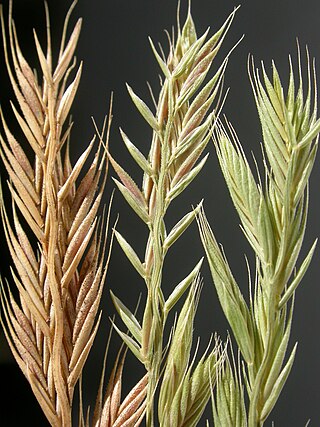
Forage is a plant material eaten by grazing livestock. Historically, the term forage has meant only plants eaten by the animals directly as pasture, crop residue, or immature cereal crops, but it is also used more loosely to include similar plants cut for fodder and carried to the animals, especially as hay or silage.

Festuca (fescue) is a genus of flowering plants belonging to the grass family Poaceae. They are evergreen or herbaceous perennial tufted grasses with a height range of 10–200 cm (4–79 in) and a cosmopolitan distribution, occurring on every continent except Antarctica. The genus is closely related to ryegrass (Lolium), and recent evidence from phylogenetic studies using DNA sequencing of plant mitochondrial DNA shows that the genus lacks monophyly. As a result, plant taxonomists have moved several species, including the forage grasses tall fescue and meadow fescue, from the genus Festuca into the genus Lolium, or alternatively into the segregate genus Schedonorus.

Festuca ovina, sheep's fescue or sheep fescue, is a species of grass. It is sometimes confused with hard fescue.

Festuca pratensis, the meadow fescue, is a perennial species of grass, which is often used as an ornamental grass in gardens, and is also an important forage crop.

Festuca altaica, also known as the altai fescue, or the northern rough fescue, is a perennial bunchgrass with a wide native distribution in the Arctic, from central Asia to eastern North America. It was first described in 1829 by Carl Bernhard von Trinius. It is under the synonym F. scabrella, the rough fescue.

Acacia stenophylla is a species of Acacia commonly referred to as the shoestring acacia. It is an evergreen tree in the family Fabaceae native to Australia. It is not considered rare or endangered.

Festuca rubra is a species of grass known by the common name red fescue, creeping red fescue or the rush-leaf fescue. It is widespread across much of the Northern Hemisphere and can tolerate many habitats and climates. It is best adapted to well-drained soils in cool, temperate climates; it prefers shadier areas and is often planted for its shade tolerance. Wild animals browse it, but it has not been important for domestic forage due to low productivity and palatability. It is also an ornamental plant for gardens.

Festuca arundinacea (syn., Schedonorus arundinaceus and Lolium arundinaceum) is a species of grass commonly known as tall fescue. It is a cool-season perennial C3 species of bunchgrass native to Europe. It is an important forage grass throughout Europe, and many cultivars have been used in agriculture. It is also an ornamental grass in gardens, and a phytoremediation plant.

Festuca occidentalis is a species of grass known as western fescue. It is native to much of the northern half of North America and is most widely distributed in the west. It is most often found in forest and woodland habitat. The specific epithet occidentalis is Latin, meaning "western".

Festuca vivipara, the viviparous sheep's-fescue, is a species of grass native to northern Europe, northern Asia, and subarctic North America. The specific epithet vivipara is Latin, referring to the florets' alteration to leafy tufts. The plant can have a diploid number of 28, 49, 56, or 63, though numbers of 21, 35, and 42 have also been reported.

Festuca thurberi is a species of grass known by the common name Thurber's fescue. It is native to a section of the western United States encompassing New Mexico, Utah, Colorado, and Wyoming. It probably also occurs in parts of Arizona.
Leymus innovatus is a species of grass known as downy ryegrass, boreal wildrye, hairy wildrye, fuzzyspike wildrye, northern wildrye, and northwestern wildrye. It is native to northern North America from Alaska to eastern Canada and south to Colorado.

Festuca gigantea, or giant fescue, is a plant species in the grass family, Poaceae. Because this and other members of Festuca subgenus Schedonorus have more in common morphologically with members of the genus Lolium than with Festuca and often produce fertile hybrids with other Lolium species, Festuca gigantea has been recently published as Lolium giganteum(L.) Darbysh. (1993) and then as Schedonorus giganteus(L.) Holub (1998). Sources vary as to which placement is more acceptable.
Festuca frederikseniae is a species of grass native to Greenland, Newfoundland, Labrador, and to a few islands in eastern Québec. In Iceland and southern Greenland, a few populations have been found that may be hybrids between F. rubra and either F. frederikseniae or F. vivipara. The purported hybrids have been named F. x villosa-vivipara. All these species grow on cliffs and on rocky or sandy soils in alpine tundra. It was first described in 1985.

Festuca octoflora, also known as Vulpia octoflora, is an annual plant in the grass family (Poaceae). The common name six week fescue is because it supplies about 6 weeks of cattle forage after a rain. Other common names include sixweeks fescue, six-weeks fescue, pullout grass, eight-flower sixweeks grass, or eight-flowered fescue.

Sylvia Anita Edlund was a Canadian botanist. Festuca edlundiae, commonly known as Edlund's fescue, a high arctic grass, was named in her honour for her extensive contributions to Arctic field work.
Festuca edlundiae, commonly known as Edlund's fescue, is a native, perennial tufted grass found in Alaska, Canadian arctic islands, northern Greenland, far eastern arctic Russia and Svalbard. The specific name honours Doctor Sylvia Edlund, a Canadian botanist. It was first described by Susan Aiken, Laurie Consaul and Leonard Lefkovitch in 1995.

Festuca brachyphylla, commonly known as alpine fescue or short-leaved fescue, is a grass native to Eurasia, North America, and the Arctic. The grass is used for erosion control and revegetation. The specific epithet brachyphylla means "short-leaved". The grass has a diploid number of 28, 42, or 44. This species was first described in 1827.

Festuca saximontana, the rocky mountain fescue or the mountain fescue, is a perennial grass native to North America. The specific epithet saximontana is Latin and means "of the Rocky Mountains". The grass has a diploid number of 42.
















